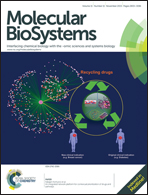Construction and analysis of correlation networks based on gas chromatography-mass spectrometry metabonomics data for lipopolysaccharide-induced inflammation and intervention with volatile oil from Angelica sinensis in rats†
Abstract
Angelica sinensis (AS) is a well-known important traditional Chinese medicine that yields a volatile oil with anti-inflammatory effects. However, the holistic therapeutic effects and the mechanism underlying such effects of the volatile oil of A. sinensis (VOAS) are not yet well understood. Here, a gas chromatography-mass spectrometry-based metabonomic study was conducted to explore the significantly altered metabolites for better understanding of VOAS and to assess the integral efficacy of VOAS on a lipopolysaccharide (LPS)-induced inflammation rat model. Principal component analysis was used to investigate the global metabonomic alterations and to evaluate the therapeutic effects of VOAS in rats. Clear separations were observed in the comparison of the metabolite profiles of the normal control (NC) group, the LPS-stimulated group (MI), the VOAS group, and the dexamethasone (Dex) group. VOAS exerted therapeutic effects on the LPS-stimulated group, which were in accordance with the results of cytokine analyses and blood physiobiochemical assay. Furthermore, a total of 20, 17, and 22 metabolites distributed in 27 metabolic pathways were respectively identified in plasma, liver, and lung samples as significantly altered metabolites of MI, VOAS, Dex, and NC of the same background. Network analysis revealed that glycine, glutamate, malic acid, succinate, arachidonic acid, glycerol, galactose, and glucose were hub metabolites of the inflammation correlation network. Results indicated that VOAS exhibited an anti-inflammatory effect by adjusting the Krebs cycle, improving the glucose content, and restoring the fatty acid metabolism.



 Please wait while we load your content...
Please wait while we load your content...